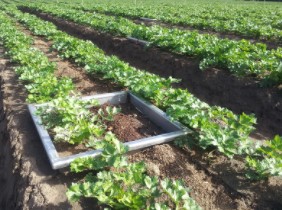By Kaine Korzekwa
The element nitrogen is a double-edged sword. It is essential for growing plants and feeding people, but it is also a leading cause of pollution across the world. Only by using nitrogen more sustainably can the positive and harmful effects of nitrogen be balanced.

To measure greenhouse gas emissions from manure application on a celery farm, researchers covered some of the plants with chambers that would trap the gases. The metal border is the base of the chamber.
Xia (Emma) Liang, a member of the American Society of Agronomy, studies nitrogen loss during food production.
“This framework can capture the environmental impacts and societal costs of nitrogen losses,” Liang explains. “This allows us to potentially provide information to inform consumers, producers, and policymakers.”
The team hopes this research will help make major progress in making agricultural systems across the world more sustainable,
less polluting, and more profitable.
Their framework measured both overall nitrogen loss and nitrogen loss intensity. The latter is the loss per unit of food or per unit of nitrogen produced. This allowed better comparisons across different crops and food items.
For example, cereal grains have a low loss intensity but a high overall loss because they are grown in such large quantities. On the other hand, an animal product like buffalo meat has a high loss intensity but a low overall loss. This is due to the small amount produced.
Static chambers are used in fields to measure greenhouse gases. This helps scientists determine the effect of fertilizers on improving nitrogen use efficiency.
The framework reveals that the loss quantity and loss intensity vary a lot for different food products, especially when compared between farmers and countries. The database includes 115 crop and 11 livestock commodities at the global scale.
Cattle contribute the most to global nitrogen pollution. They are followed by the production of rice, wheat, maize, pork, and soybeans. Beef is also the food with the highest loss intensity, followed by lamb, pork and other livestock products. Generally, the loss intensity of livestock is much larger than the loss intensity of crop products.
“The lowest nitrogen loss for the 11 livestock products exceeds that of vegetable substitutes,” Liang says. “This confirms the importance of dietary change to reduce nitrogen loss through consumption.”
The nitrogen loss from fields can cause harm in multiple ways. It can cause smog and further climate change. It harms soil and water, as well as the plants and animals that live there. For humans, high levels of nitrogen in the air and water have been connected to illness.
Liang highlights that with current activities, the planet’s nitrogen boundary, a “safe operating space” for humanity, is exceeded by over two-fold.
Solutions are complex. On farms themselves, there are many techniques to better manage nitrogen. These include better fertilizer technologies and practices, improved crop varieties, and following the “4 Rs.” This means using the right fertilizer in the right amount at the right time in the right place. There are also ways to improve nitrogen management in livestock.
Click here to see more...